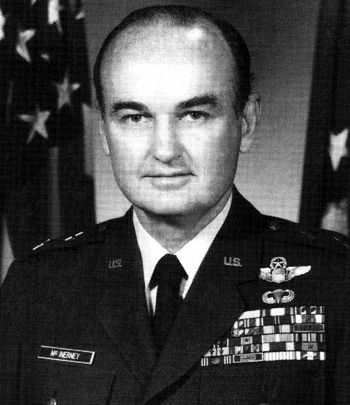
|
James E. McInerney, Jr. |
 |
|||
| Rank, Service | ||||
Major General O-8, U.S. Air Force |
||||
| Veteran of: | ||||
|
||||
| Tribute: | ||||
James McInerney was born on August 3, 1930, in Springfield, Massachusetts. He enlisted in the U.S. Army on September 8, 1947, and served as a parachute infantryman with the 82nd Airborne Division at Fort Bragg, North Carolina, until his discharge on June 8, 1948, when he was accepted into the U.S. Military Academy at West Point. McInerney entered the academy on July 1, 1948, and was commissioned a 2d Lt in the U.S. Air Force on June 3, 1952. He completed pilot training and was awarded his pilot wings in September 1953, and he then completed Fighter Interceptor training in December 1953. Lt McInerney served with Air Defense Command from December 1953 to April 1954, followed by service with the 80th Fighter-Bomber Squadron at Suwon AB, South Korea, from April to September 1954. He next transferred to Japan where he served with the 35th Fighter-Bomber Squadron at Itazuke AB from September 1954 to September 1955. During this time, he was awarded the Distinguished Flying Cross for a probable aerial victory against a North Korean MIG when his flight of 8 F-86 fighters was attacked by 16 MIG fighters on May 10, 1955, in a little-known Cold War air battle. His next assignment was with the 1738th Ferrying Squadron with the Military Air Transport Service (MATS) at Kelly AFB, Texas, from October 1955 to March 1958, followed by service on the staff of Headquarters MATS at Scott AFB, Illinois, from March to August 1958. Capt McInerney next received an Air Force Institute of Technology assignment to Princeton University, where he graduated with a Master's degree in aeronautical engineering in June 1960, and then served as an aeronautical engineer in the Research and Development Section of the Air Force Fighter Weapons School at Nellis AFB, Nevada, from June 1960 to January 1964. Maj McInerney attended Royal Air Force Staff College in Bracknell, England, from January to December 1964, and then served with the 53rd Tactical Fighter Squadron (TFS) at Bitburg AB, West Germany, from January to August 1965. His next assignment was with the 36th Tactical Fighter Wing (TFW) at Bitburg AB from September 1965 to March 1967, followed by a deployment to Southeast Asia. Col McInerney served as Operations Officer and then Commander of the 13th TFS at Korat Royal Thai AFB, Thailand, from March to October 1967, and then as Commander of the 44th TFS at Korat from October to November 1967. During this time he flew 111 combat missions in the F-105 Thunderchief. He served as a staff officer with Headquarters Pacific Air Forces at Hickam AFB, Hawaii, from November 1967 to August 1969, and then attended National War College from August 1969 to August 1970. Col McInerney served with Headquarters U.S. Air Force in the Pentagon from August 1970 to October 1971, followed by service as Commander of the 86th TFW (later redesignated the 26th Tactical Reconnaissance Wing) at Zweibrucken AB, West Germany, from October 1971 to July 1973. Gen McInerney was chief of the Air Force Section for the Joint U.S. Military Mission for Aid to Turkey from July 1973 to July 1975, and then served another tour with Headquarters U.S. Air Force in the Pentagon from August 1975 to July 1978. He served as commandant of the Industrial College of the Armed Forces at Fort Lesley J. McNair in Washington, D.C., from July 1978 to January 1979, and then served as Director of Programs in the Office of the Deputy Chief of Staff for Programs and Analysis with Headquarters U.S. Air Force in the Pentagon from January 1979 until his retirement from the Air Force on October 1, 1980. Gen McInerney is a Command Pilot and accumulated over 5,400 flying hours during his Air Force career. James McInerney died on October 14, 2014. |
||||
|
||||

